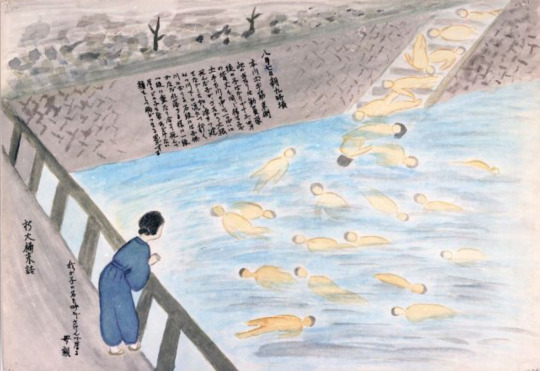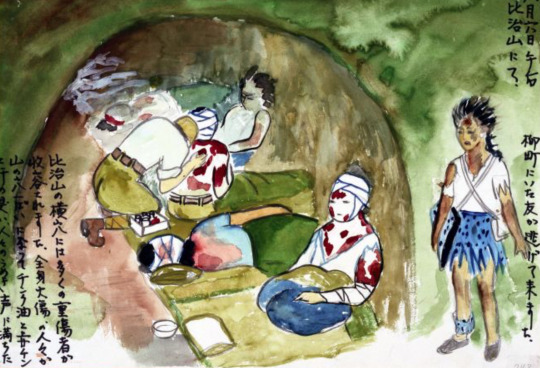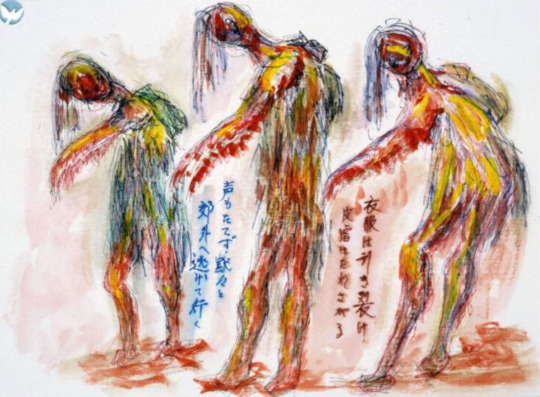Text
The Bomb That Changed the World: A Glimpse into Tragedy
On August 6, 1945, the world witnessed a tragedy that would change Japan when the United States dropped the atomic bomb “Little Boy” on Hiroshima, a Japanese military city. Buildings collapsed, trees were set on fire, and temperatures near the blast reached 7,000°F. Radiation leaked into the air, water, and soil, leading to sickness and death long after the explosion. Roughly 70,000–80,000 people were killed instantly, and by the end of the year, about 140,000 had perished from injuries and radiation exposure. The city was left in ruins, with 70% of its buildings destroyed.



The devastation did not just destroy structures—it left haunting marks. One of the most chilling remnants of that day was the shadows of people etched onto walls, steps, and streets. These “atomic shadows” were the imprints of individuals vaporized in the blast, their forms permanently burned into the surfaces where they stood. These shadows are silent and ghostly reminders of the lives that ended in an instant, preserving the memory of ordinary people who were simply going about their day.
But beyond the political impact, Hiroshima’s story is deeply personal. The survivors—known as hibakusha—faced unimaginable physical and emotional scars. Many suffered from radiation sickness, cancer, and severe psychological trauma. They also endured social stigma, as those exposed to radiation were often seen as “tainted,” making it difficult to find work, start families or marry. Despite these challenges, hibakusha united to advocate for nuclear disarmament and fight for fair treatment, demonstrating remarkable resilience.



In the years that followed, many hibakusha turned to art as a way to process their pain and preserve the memories of the horrors they endured. Their drawings vividly depict the destruction: collapsed buildings, charred landscapes, and scenes of chaos. Some of the most striking images show survivors walking with their arms outstretched, skin hanging from their bodies—a grim reflection of the burns caused by the intense radiation. Others show parents searching desperately for their children or families torn apart, illustrating the profound emotional toll.
The drawings serve not only as historical records but also as emotional expressions, providing a glimpse into the unimaginable suffering and loss. Amid the devastation, however, there are also symbols of hope. Some artworks depict cherry blossoms blooming among the ruins or rising suns, representing the resilience of the human spirit and the determination to rebuild. These images remind us that even in the face of overwhelming tragedy, humanity can find a way to heal and move forward.



Today, Hiroshima stands as a symbol of peace. Rebuilt and thriving, the city honors its past through remembrance ceremonies and the Hiroshima Peace Memorial Museum, which houses many of the survivors’ artworks. These pieces ensure that future generations never forget the human cost of nuclear weapons and the enduring message of peace. The shadows, the art, and the voices of the hibakusha continue to remind the world of the importance of striving for a future free of nuclear warfare.
youtube
4 notes
·
View notes
Text
A Journey of Art and Expression
As a college student who is under pressure for the lectures, assignments, and deadlines, it is easy to lose yourself that only wants to show your creativity and expression. For me, anime and manga have become more than just entertainment. Now it is my inspiration through which I illustrate my emotions. What began as a hobby has developed into a source of inspiration, shaping not only my art but the type of person I am today.
I never imagined that something so simple would completely change my life. But it did. It was three years ago that I began to experiment with my own art, using anime and manga as my foundation. I found that their different art styles from minimalist sketches to highly detailed drawings offered me possibilities for creative exploration.
It all began with Junji Ito. His works were my first taste of horror that felt deeply artistic. The numerous details of his drawings, the creepy atmosphere he created, and the way his stories twisted reality. I saw that art wasn't just about creating something "horrifying" , it was about illustrating feelings. Junji Ito's work taught me that art can be raw, intense, and real.
At the same time, anime like Attack on Titan and One Piece started shaping my understanding of how deep stories could be. Attack on Titan showed me a world on the border of collapse, where the characters fought not just against giants, but for their very freedom and identity. The themes of survival and courage hit me hard. In One Piece, a story about dreams and adventure reminded me that no dream is too big, and no obstacle too difficult.
These shows taught me the importance of resilience and how challenging life can be, and how storytelling through art could be both deeply personal and universal at the same time. From personal growth and sacrifice to racism and violence, these stories talk about the complexities of life. Characters often overcoming tremendous obstacles, serve as reminders that perseverance and self-discovery are not always easy paths.
Today, I use anime and manga not only as a personal escape but as a tool to engage with others. Connecting over shared passions and experiences. It’s not just about drawing, but about drawing my emotions, my growth, and my journey finding my place in the world. Through every stroke, I am creating not only art but a piece of myself.

youtube
15 notes
·
View notes